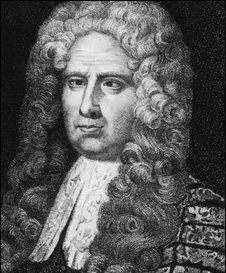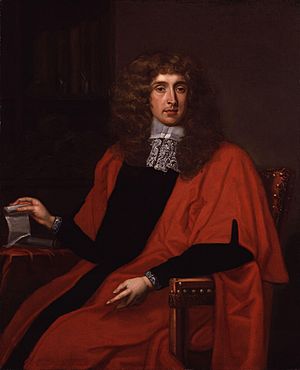Loyal Parliament facts for kids

The Loyal Parliament was the only parliament that met during the reign of King James II of England. It was called 'Loyal' because most of its members were very supportive of the new king at the start. The Whigs, who didn't want James to become king, had fewer members than the king's supporters in both the House of Commons and the House of Lords.
In May 1685, this Parliament gave King James a lot of money. But by November, they started to worry about his decisions. So, he stopped them from meeting again. King James never called another parliament before he left the country in 1688. This happened during an event called the Glorious Revolution.
Contents
Why the Loyal Parliament Was Important
King James II and His Challenges
King James II faced a big problem: he was Catholic. Most people in England were Anglican (Protestant). This made it hard for him to get along with both main political groups. The Whigs especially did not like his religion.
Before James became king, the Whigs tried to pass a law called the Exclusion Bill. This law would have stopped James from becoming king because he was Catholic. His brother, King Charles II, had a very hard time stopping this law.
James's main supporters were the High Anglican Tories. These Tories had opposed the Exclusion Bill.
How Members Were Chosen
The elections in 1685 for the House of Commons were greatly influenced by the king. After the fight over the Exclusion Bill, many towns received new official papers called charters. The king used these to reduce the power of the Whigs.
Because of this, there were only 57 Whigs in the new House of Commons. Just four years earlier, the Whigs had been the majority. The Whigs also lost seats in the countryside, dropping from about 60 to only eight. In this new Parliament, the Tories had a majority in both the Commons and the House of Lords.
Key Events of the Parliament
First Meetings and Decisions

The king called Parliament to meet on May 19. On May 22, John Trevor, a Tory who supported James, became the Speaker of the Commons. The king also chose Lord Jeffreys to be the Lord Chancellor.
The first part of Parliament's meeting lasted from May 19 to July 2, 1685. For many years, it was a tradition for Parliament to give a new king or queen money for life. This money came from taxes on goods like wine and wool. In 1625, the Parliament of Charles I broke this tradition. They only gave him money for one year.
In 1685, a Tory named Sir Edward Seymour suggested that Parliament should check for election problems before giving the king any money. But no one supported his idea. So, Parliament gave King James money for life. They also added high taxes on sugar and tobacco, even though traders protested. One historian called this Parliament "the most loyal Parliament a Stewart ever had."
Rebellions and Royal Power
In June and July 1685, there was a rebellion in England led by the Duke of Monmouth. At the same time, a smaller rebellion happened in Scotland. These events showed that not everyone accepted James as king. However, the rebels did not have Parliament's support.
In November 1685, Lord Delamere was put on trial in the House of Lords. He was accused of helping the rebellion. King James chose Judge Jeffreys to lead the trial. Jeffreys picked 30 peers (noblemen) to help him. These 30 men were known to be against Lord Delamere. Fifteen of them were army officers who could be removed by the king.
Even so, all 30 men voted that Lord Delamere was not guilty. This made King James very angry. This event marked the end of the king's revenge on the rebels.
During the rebellion, James raised a large army to fight. He also gave many important positions to Catholics. After the rebellion, it became clear that James wanted to keep this large army. He could do this because Parliament had given him a lot of money. This made many people worried. They feared that England would be ruled by a Catholic king with a Catholic army.
Parliament's Opposition and End
On November 9, 1685, King James gave a speech to Parliament. He said he wanted to get rid of the Test Acts. These laws stopped Catholics from holding public jobs, especially in the army. This idea was strongly opposed by both Tories and Whigs.
On November 13, there was an important vote. It was about whether to give the king more money before discussing the country's problems. The king's supporters lost by one vote: 182 for the king and 183 against.
King James reacted by stopping Parliament from meeting on November 20, 1685. He kept stopping Parliament from meeting again and again. He did this to silence their opposition. Parliament was finally officially ended on July 2, 1687.
What Happened Next
No other parliaments met before King James was overthrown in the Glorious Revolution of 1688. He did try to call a parliament in September 1688. It was supposed to meet in November. But the elections were canceled because William of Orange was about to invade England.
After losing badly against William's forces, James went back to London. He then fled the country on December 18, 1688. A special meeting called the Convention Parliament met on January 22, 1689. This meeting was called by William. It included the House of Lords and the members of the Commons from the last parliament of Charles II's reign. This group invited William III and Mary II to become the new king and queen.
In Books
The Loyal Parliament is shown in a historical novel called Lillibulero by Robert Neil. The main character in the book is a Tory Member of Parliament. He becomes worried when the King wants to keep a large army and bring back the Catholic Church. So, he joins with the Whigs to stand up to the King. This makes the King angry and eventually leads the character to support the Glorious Revolution.
See also
- List of parliaments of England
- 1685 English general election
- Duration of English, British and United Kingdom parliaments from 1660
- Exclusion Bill

